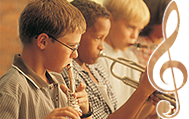Phonemic Awareness, K-1
Submitted by Caryn Mears, Kennewick, Washington
Idea posted 2007-01-03
I use a special box with my kindergartners. Each time they come into the music room, it contains an item from the music room or an item that would help teach a lesson (coordinated with the letters or theme that the kindergarten teacher is teaching). For instance, the alphabet card the school uses for the letter 'B' is a picture of "Bobby's Basketball," so then we had a miniature basketball in the box. We practiced bouncing imaginary basketballs to the beat. During the next lesson, we bounce real basketballs to the beat. Some of the examples in the box are items from the music room, so we also did 'bells' when they were learning about the letter 'b.' I like to be imaginative with this activity, and the kids absolutely love it. We sing a little song:
Oh Magic Music Box, Oh Magic Music Box,What have you brought today?
When we are finished with the box, I put the object back in the box and we sing,
Thank you Magic Music Box!
T-H-A-N-K, T-H-A-N-K, T-H-A-N-K!
We thank you very much! Hey!
We put a lot of emphasis on beginning and ending sounds. I purchased stuffed animals that correspond to the vowels to use with "Old MacDonald."
"Old MacDonald had a farm, A, E, I, O, U. And on his farm he had some vowels, A, E, I, O, U. With an "aa" here and an "aa" there, here an "aa," there and "aa," everywhere an "aa aa." Old MacDonald had a farm, A, E, I, O, U. And on his farm he had an E. A, E, I, O, U. With an "ee, ee," here and an "ee, ee" there. Here an "ee," there an "ee," everywhere and "ee, ee," etc."We also do "Apples And Bananas," and I say, "What if the letter A got to say his own name?" etc., so we are learning both the short and long vowel sounds on this song.
We also sing songs that emphasize writing and reading concepts. For instance, to the tune of "B-I-N-G-O":
I know a punctuation mark that's used to show emotion,Exclamation point, Exclamation point, Exclamation point.
It's used to show emotion!
To the tune of "Where, Oh Where Has My Little Dog Gone?"
Oh where, oh where is the question mark?
Oh where, oh where can it be?
With a who, what, when, where and why, and how?
Oh where, or where can it be?
To the tune of "Frère Jacques (Are You Sleeping?)"
Verbs show action. Verbs show action.
I like verbs. I like verbs.
Verbs show what we're doing,
they show us lots of action.
I like verbs. I like verbs.
My own tune:
It's a noun. -do, re, mi- (clap, clap) It's a noun. -do, re, mi- (Clap, clap)
It's the name of a person, place, or thing.
-do, re, mi- -mi, mi, fa, fa- -mi, mi, re.-
It's a noun. -do, re, mi- (clap, clap) It's a noun. -do, re, mi- (Clap, clap)
It's the name of a person, place, or thing.
-mi, mi, sol- -sol, sol, fa, fa- -re, re, do.-
To the tune of "Mary Had A Little Lamb"
Sentences will always start, always start, always start...
sentences will always start with a capital letter.
When you have at least three words, at least three words, at least three words...
when you have at least three words, you end it with a stop dot.
With the first graders, I use a song about compound words:
To the tune of "On Top Of Old Smokey"
Put two words together to make a new word.
The two words are compound, a new word will be heard.
Then have the children come up with compound words with your first word...
Such as snow... side... air... blue... etc.
1. Chanting, chanting, chanting! Lots of chants! I now teach a new chant every week to my all of my elementary students: "Miss Mary Mack," "Engine Engine No. 9," etc.
Try using poems or chants that match the letter of the alphabet they are learning.
2. Syllables - ask them how many syllables are in a word - their name, animals, etc.
3. Rhyming - singing and chanting in rhyme. Have them name the rhyming words, etc.
Read rhyming books and have them pat or clap to keep the beat. Also incorporate instruments on the rhyming words or help them recognize the sounds that rhyme.
4. It is very important that when students learn songs, every child can accurately pronounce every word in every song. Students should also understand the meaning of every word they are singing.
I think we have such a special position. We can reach those students who learn through rhythmic patterns and music when they might not get it through just sitting in a classroom. It's exciting to make their learning fun!
